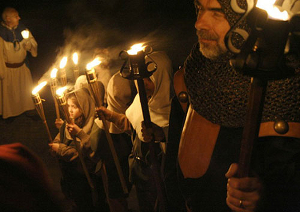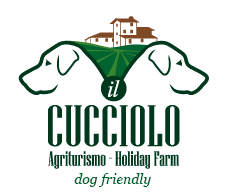 Easter weekend is full of traditional events all over Italy, starting from the numerous procession and “via crucis” on the night of Good Friday. In Umbria, Città Castello has the oldest traditional procession with the dead Christ. It dates to 1230, when the people in charge of carrying the dead represented a funeral procession with a statue of the dead body of Christ. It has been many years now that this ritual event takes place in the main center of the Medioeval town. In the dark, people in traditional costumes form a procession lightened by fires: tambourines, trumpets, the representatives of the Arts, the Captain of the population, the soldiers and many other figures. In the end there are the dead people porters, dressed in a black tunic with pointed hats, golden crosses, a skull on a red pillow, some of them carrying the dead body of Christ on their shoulders.
Easter weekend is full of traditional events all over Italy, starting from the numerous procession and “via crucis” on the night of Good Friday. In Umbria, Città Castello has the oldest traditional procession with the dead Christ. It dates to 1230, when the people in charge of carrying the dead represented a funeral procession with a statue of the dead body of Christ. It has been many years now that this ritual event takes place in the main center of the Medioeval town. In the dark, people in traditional costumes form a procession lightened by fires: tambourines, trumpets, the representatives of the Arts, the Captain of the population, the soldiers and many other figures. In the end there are the dead people porters, dressed in a black tunic with pointed hats, golden crosses, a skull on a red pillow, some of them carrying the dead body of Christ on their shoulders.
Montone, another Medieval jewel, has also a procession on Good Friday, but I rather like visiting the town on Monday Morning or Angel’s Monday. Closing the weekend, It is then that the reenactment of an event from 1474 takes place, called “The donation of the Sacred Spine”. Captain Carlo Fortebraccio, born in Montone, while serving the republic of Venice and chasing away the Turks from the venetian coastline, received as a gift a spine from the preserved crown on Christ’s head and donated to the population to his town Montone. Nowadays the event is acted in traditional costumes on the main square at 10:30 in the morning, with all the important characters of the time featured, and then a solemn Mass follows in the Church where the Sacred Sapine is preserved. Another unique procession is the one in Bastia Umbra, called the “Rinchinata” (from the term “inchinarsi” which means bending). It happens at 5pm on Easter Sunday and it is the meaning of two processions, one following the statue of the Madonna an one following the statue of the Resurrected Christ, until they meet and the statue are guided to bend to each other. From the kind of bending people are catching good wishes for the harvest.
During the weekend, every town shows historical and food traditions, with markets or eggs hunts, like the one organised in Città di Castello at the “Garavelle People Traditions Center”. This eggs hunt is for children from 5 to 10 years old and it is organised for saturday afternoon by the association PoliedroCultura. It costs 5,00 € and a reservation is required. The game named “Tocciata” in Pietralunga on Easter morning has also to do with eggs. At 11 am in the center of ton people will make circles holding a hard boiled egg and they will hit each other egg, by breaking them and eliminating the holder, until the last one is left whole.
Another Umbrian custom is the live paintings. Fascinating the ones in Città della Pieve, in the underground of Palazzo Orca (Via Roma), on Sunday and Monday. Real people form several live paintings, acting still, dressed in order to represent scenes of the Passion, Death and Resurrection of Christ, inspired by traditional italian paintings. This year you can visit the exhibition named “Passione impressa“, which tells the history of the past 25 years events.
Not only sacred events, but also markets will be happening all over. In Perugia’s Rocca Paolina, there is the Great Easter Fair, an art craft and food exhibition.
Nothing better than ending the weekend with a free concert in the Duomo of Orvieto, Monday afternoon at 5:30pm. The “Orchestra del Maggio Musicale Fiorentino” directed by Zubin Metha will play the Symphony n. 6 Op. 74 “Patetica” from P. J. Tchaikowskj and the event will be filmed by national TV.
While visiting Umbria, even for just one long weekend, there are some exhibition of interest. In Gubbio the one about Dinosaurs is special for families with kids. It is in the San Benedetto Monastery and it is connected with an itinerary through the town which arrives to the Gola del Bottaccione, place of study about the extinction theory regarding a meteorite hitting the Earth. Steve Mc Curry has a project also based in Gubbio, regarding the famous “Corsa dei Ceri” which happens in May. It is called “Passionate Umbria” and it is described by the artists with these words: “I thought I would see three saints and I saw three Candels. I thought I would see a city and I saw a people. I thought I would see a party and I saw life itself”.
Last but not least, 2015 is the 100 years anniversary of the date of birth of the Italian Painter Alberto Burri, born in Città di Castello the 12th of March 1915 and dead in Nice the 13 of February 1995. Another reason to visit the Palazzo Albizzini Collezione Burri Foundation and the Ex Seccatoi del Tabacco to know deeply the entire evolution of the famous artist.
By Marta Cerù
